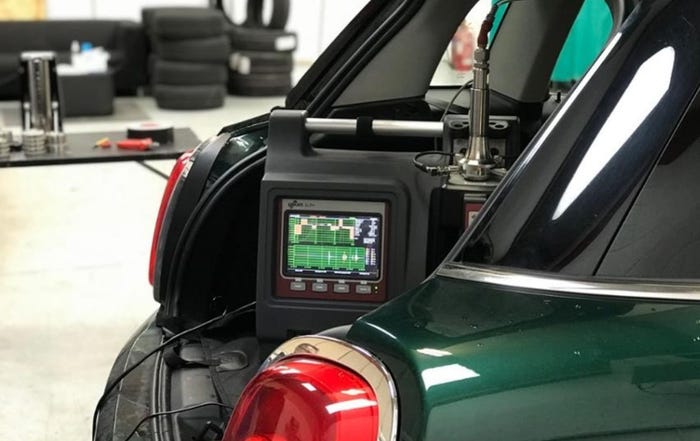Competition Through Collaboration
WARWICKSHIRE, U.K. - The Motor Industry Research Assn. is in the right place at the righttime.The Labour Party has come into power here clearly perceived as anti-automobile and with a mandate to clean up the environment. Random vehicle emissions testing already is resulting in $100 fines, to be paid on the spot. Alternative-fuel and hybrid vehicles suddenly are the rave as the U.K. begins testing

WARWICKSHIRE, U.K. - The Motor Industry Research Assn. is in the right place at the righttime.
The Labour Party has come into power here clearly perceived as anti-automobile and with a mandate to clean up the environment. Random vehicle emissions testing already is resulting in $100 fines, to be paid on the spot. Alternative-fuel and hybrid vehicles suddenly are the rave as the U.K. begins testing its first fuel cell-powered urban bus.
What does it all mean? More work for MIRA, which is an engineering services association specializing in vehicle development and testing in areas such as powertrain and emissions, fluid dynamics, noise and vibration, safety and chassis engineering and electronic systems.
MIRA traces its roots to 1946, when the U.K. motor industry was rebuilding after World War II. It became a private company in the 1970s, with member businesses, universities and other organizations paying subscription rates to take advantage of MIRA's vast resources.
Automotive suppliers engaged in vehicle testing are common, especially today as OEMs continuously hand down more engineering responsibilities. But MIRA is different because of its independence. It is an association that draws strength from member companies with unique technologies to offer.
Illustrating this relationship is the Foresight Vehicle, Britain's attempt to develop efficient, clean and safe cars of tomorrow by tapping 250 U.K. suppliers, including MIRA, as well as automakers and universities. It is similar to the Partnership for a New Generation Vehicle in the U.S.
Because its customer and member base is so diverse, MIRA's headquarters here is, to put it mildly, highly secure to maintain confidentiality. Uniformed guards stand watch and offer admittance to visitors only after thorough questioning. (The property, after all, was once an RAF airfield.) High-ranking MIRA executives are miffed when denied electronic access to the headquarters building while hosting visiting American journalists.
They've gotten used to excessive security as the facility has grown in recent years, with a new radio frequency interference (RFI) lab, an enhanced model wind tunnel and a new material technology laboratory. In all, MIRA has 20-some laboratories, as well as an office in Seoul, Korea.
In November, MIRA expanded its proving grounds with a wet handling course funded by five member companies - Dunlop Tires, Honda of Europe, Jaguar Cars Ltd., Nissan European Technology and Rover Group. It's the first of its kind in Europe that is independent and available to the entire auto industry.
MIRA will open a fluids engineering center later this year, about the same time it opens an electromagnetic compatibility (EMC) lab at its North American engineering headquarters in Plymouth, MI. One MIRA official says the Big Three "were a catalyst" behind MIRA's new investment in the U.S., but that demand for time in the EMC also is heavy from global Tier 1 and Tier 2 suppliers.
For Managing Director John Wood, MIRA should play a key role in helping usher the British auto industry into a new era of high technology.
"I have long held the view that building an industrial economy on the premise that the U.K. is a cheap place to screw things together is fatally flawed," Mr. Wood says.
"If we are to attract and more importantly retain inward investment, we have to do it on the basis that this is where the intellectual value-added is found, that this is where the greatest concentration of experience and expertise in vehicle and powertrain design and development is based," he says.
The British auto industry needs a boost financially and psychologically. Many Brits see Jaguar, Rover and Rolls-Royce now in foreign hands and are concerned that British workers will be the first to lose jobs in the event of a global economic meltdown, simply because it is the easiest option for foreign owners of the OEMs.
For MIRA, foreign ownership of the historically British nameplates is opening doors to new markets and is forcing MIRA's Automotive Information Centre to expand its resources with regard to vehicle standards overseas. About 56% of cars produced in the U.K. are exported.
In recent years, MIRA helped develop the Daewoo Leganza, Ford's small Courier pickup for Brazil, Ford's ZX2 coupe for the U.S. and the 440 Volvo. It even assisted Lamborghini in equipping its exotic Diablo roadster and coupe with air bags.
MIRA has something else going for it: tax free status as a research establishment. That's no small matter in a land with a historical penchant for taxation (remember the American Revolution?) and where gasoline costs nearly $5 a gallon, 83% of which is tax.
Read more about:
1999About the Author
You May Also Like





